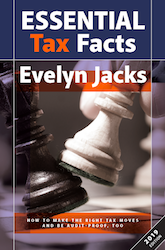Essential Tax Facts: Education Planning with RESPs

Beth Graddon
A Registered Education Savings Plan (RESP) is a tax-assisted savings plan set up for the purposes of funding a beneficiary’s future education costs. It also serves as a way to split income earned in the plan with the beneficiary, who will be taxed at a lower rate than the contributor, as a general rule, when earnings are withdrawn.
Excerpted from Essential Tax Facts by Evelyn Jacks
What gives the RESP added weight as an important family investment, is that the federal government encourages family educational savings by contributing to your efforts with the Canada Education Savings Grants and Canada Learning Bonds .
A contributor can invest up to $50,000 per beneficiary as a lifetime maximum. But, government contributions are maximized if contributions are spread over time rather than in one lump sum. You should also know:
- The plan must terminate after 35 years (unless the beneficiary is disabled).
- Minor siblings can substitute as plan beneficiaries if the intended beneficiary does not become a qualifying recipient.
Transfers may be made between RESPs with no income tax consequences. In fact, tax-free transfers between individual Registered Education Savings Plans (RESPs) for the benefit of  siblings will be allowed without triggering the repayment of Canada Education Savings Grants (CESGs) so long as the beneficiary of the recipient plan is less than 21 years old at the time of the transfer.
siblings will be allowed without triggering the repayment of Canada Education Savings Grants (CESGs) so long as the beneficiary of the recipient plan is less than 21 years old at the time of the transfer.
There are several tax advantages to an RESP investment. The subscriber, who contributes money into the plan, does not receive a tax deduction at the time of investment. However, income earned within the plan on the contributions is tax-deferred until the beneficiary student qualifies to receive education assistance from the plan by starting to attend post-secondary school, either on a part-time or on a full-time basis.
Be sure to tap into the CESG. The sweetener to RESP savings is the Canada Education Savings Grant (CESG) which provides additional funds for education. It’s free money given to anyone who contributes to the RESP; there is no income testing.
The grant is 20% of the first $2,500 contributed to an RESP for children under the age of 18. The lifetime maximum CESG is $7,200. To receive the money, the beneficiary of the RESP must have a Social Insurance Number. The CESG room of up to $500 a year (20% of $2,500) can be maximized each year including the year the child turns 17.
Unused CESG contribution room can be carried forward until the child turns 18, however, the grant may not exceed $1,000 in any one year. This means that the catch-up of the grants is limited to two years at a time so it’s better to make contributions each year rather than in a lump sum.
An additional CESG is available if the family net income is low enough. For families with net income in the lowest tax bracket (below $47,630 in 2019, $46,605 in 2018), an additional grant is 20% of the first $500 deposited (maximum $100 additional grant).
For families with net incomes in the second tax bracket (between $47,631 and $95,259 in 2019), the additional grant is 10% of the first $500 deposited (maximum $50 additional grant).
Low Earners—Don’t Miss Out on the Canada Learning Bond (CLB). There’s more good news. The first time a child qualifies, an initial Canada Learning Bond entitlement of $500 is available.
This will generally happen under one of two circumstances:
- the year of birth or
- a subsequent year if the family net income is too high in the year of birth.
The entitlement is $100 in each subsequent year that the family is eligible until the year the child turns 15. Once 16, the CLB is no longer allocated to the child.
Qualification for the Canada Learning Bond. This entitlement is based on family net income and the number of children in the family. For families of three or fewer children, the maximum family net income is $47,630 in 2019. For larger families, the maximum family income level increases by just under $6,000 per child.
In order to turn these amounts into real money, the Canada Learning Bond must be transferred into a Registered Education Saving Plan (RESP) for the benefit of the child. This can be done at any time before the child turns 21. If the CLB is not transferred to an RESP by the time the child turns 21, the entitlement will be lost.
No interest is paid on unclaimed Canada Learning Bonds, so it is important that the CLB be transferred to an RESP as quickly as possible so that the amount can begin to earn income within the plan. The CLB transfers to an RESP do not otherwise affect the limits of contributions to the RESP and the CLB deposits are not eligible for the Canada Education Savings Grant.
In the year the child is born, if the family net income is below the upper limit of the lowest tax bracket, the parents should:
- obtain a social insurance number for the child (required for an RESP)
- open an RESP account with the new child as beneficiary*
- apply to have the Canada Learning Bond amount transferred to the new RESP.
- An extra $25 will be paid with the first $500 bond to help cover the cost
Additional educational resources: Pick up your copy of Essential Tax Facts today.
COPYRIGHT OWNED BY KNOWLEDGE BUREAU INC., 2019.
UNAUTHORIZED REPRODUCTION, IN WHOLE OR IN PART, IS PROHIBITED.